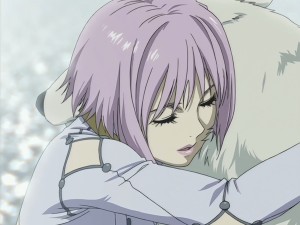Wolf’s Rain
March 6, 2018 · 0 comments
By Andrew Osmond.  “There’s no such place as Paradise… but why am I so driven to find it?” asks one of four wolves, struggling to survive in a doomed, wintry human world. Despite their suspicions of each other, the four (later five) find themselves travelling together on a journey to open the gates of Paradise.
“There’s no such place as Paradise… but why am I so driven to find it?” asks one of four wolves, struggling to survive in a doomed, wintry human world. Despite their suspicions of each other, the four (later five) find themselves travelling together on a journey to open the gates of Paradise.
These wolves can project the appearance of humans, meaning we usually see them in the guises of four young men, but often the beasts within show through. This seemingly owes less to werewolf stories than to Japanese stories about tanuki; in such stories, the creatures routinely disguise themselves as humans. In Wolf Rain’s first episode, a wolf in human guise tries to save a falling boy by “grabbing” his arm, but the lad panics as he sees jaws closing round his shoulder, and plunges to his death. But the wolves find a guide in a magical flower maiden, also sought by the powerful, ruthless Nobles – the world’s (maybe) human rulers who wield futuristic technology and mystical alchemy with equal abandon.
 This is a rich fantasy scenario. Between them, creator/writer Keiko Nobumoto (Cowboy Bebop, Tokyo Godfathers), character designer Toshihro Kawamoto (Cowboy Bebop), and director Tensai Okamura (Blue Exorcist) deliver one of the most compelling and well-told anime serials out there, an epic journey into freezing dark. The characters are excellent, especially the wolves Toboe, a sweet-natured runt still wistful for the time when he was a pet, and Tsume, a sullen, scarred loner whom the series develops at leisure.
This is a rich fantasy scenario. Between them, creator/writer Keiko Nobumoto (Cowboy Bebop, Tokyo Godfathers), character designer Toshihro Kawamoto (Cowboy Bebop), and director Tensai Okamura (Blue Exorcist) deliver one of the most compelling and well-told anime serials out there, an epic journey into freezing dark. The characters are excellent, especially the wolves Toboe, a sweet-natured runt still wistful for the time when he was a pet, and Tsume, a sullen, scarred loner whom the series develops at leisure.
On the human side, scientist Cher and detective Hubb are a strongly characterised ex-couple – unusual in anime, though strong adult characters would become a hallmark of anime by the young Studio Bones (see below). The grizzled, bitter hunter Quent vows to kill every wolf on Earth; he’s voiced in Japanese by Unsho Ishizuka, Jet in Cowboy Bebop. The “star” Japanese voices, though, include Atsuko Tanaka, Kusanagi in Ghost in the Shell, as the adversary character Jagura; and Mamoru Miyano, who’d voice Light in Death Note, as the wolf Kiba who delivers the “no such place as Paradise” line.
Compared to an anime fantasy such as Escaflowne a few years earlier, the 2003 Wolf’s Rain is emotionally darker, more adult. Its blasted, frozen surroundings make it classifiable in Western terms as a Fimbulwinter fantasy, like Game of Thrones, but Wolf’s Rain has far more romantic, lyrical moments. Witness an astounding sequence in the middle of the series where the maiden and wolves create their “road to paradise” from millions of flowers, like a vision from a Powell-Pressburger film.
Escaflowne and Wolf’s Rain are connected through their star musician, Yoko Kanno. Moreover, Kanno’s end-credits song, “Gravity”, was performed by Escaflowne’s break-out actress/singer, Maaya Sakamoto. The title song “Stray” is one of several collaborations between Kanno and American singer-musician Steve Conte, who can also be heard on Cowboy Bebop. (Both “Stray” and “Gravity” are in English.)
 For this writer’s money, though, Kanno’s finest track for Wolf’s Rain, and one of her best music pieces ever, is the heart-breaking, uplifting “Go to Rakuen” (“rakuen” is Japanese for “paradise”). This plays over the show’s stunning finale in Wolf’s Rain’s last episode, or technically its last video episode – see below.
For this writer’s money, though, Kanno’s finest track for Wolf’s Rain, and one of her best music pieces ever, is the heart-breaking, uplifting “Go to Rakuen” (“rakuen” is Japanese for “paradise”). This plays over the show’s stunning finale in Wolf’s Rain’s last episode, or technically its last video episode – see below.
Broadcast in 2003, Wolf’s Rain was one of the defining titles of the new Bones studio, soon after its mecha show RahXephon and months before its first TV version of Fullmetal Alchemist. Unfortunately, Wolf’s Rain ran into production delays and missed deadlines. The original TV transmission in Japan ran 26 episodes but four of the middle instalments (15 to 18) are recap shows that add nothing to the narrative. You can skip straight from the end of part 14 to the start of part 19 without missing anything (unless you want a plot refresher).
Wolf’s Rain has two endings – a comparable situation to Cowboy Bebop, which was broadcast in a truncated 12-part run on TV Tokyo before finding its home on other platforms, In Wolf Rain’s case, TV viewers saw the series come to a stirring climax in part 26, but more serious viewers saw the story wasn’t resolved. The last four parts (27 to 30) were released to video in Japan in early 2004, taking the story into intense and tragic territory as the apocalypse runs its course… but the closing catharsis is worth it.
Andrew Osmond is the author of 100 Animated Feature Films.
Wolf’s Rain is released in the UK by Anime Limited.
Leave a Reply